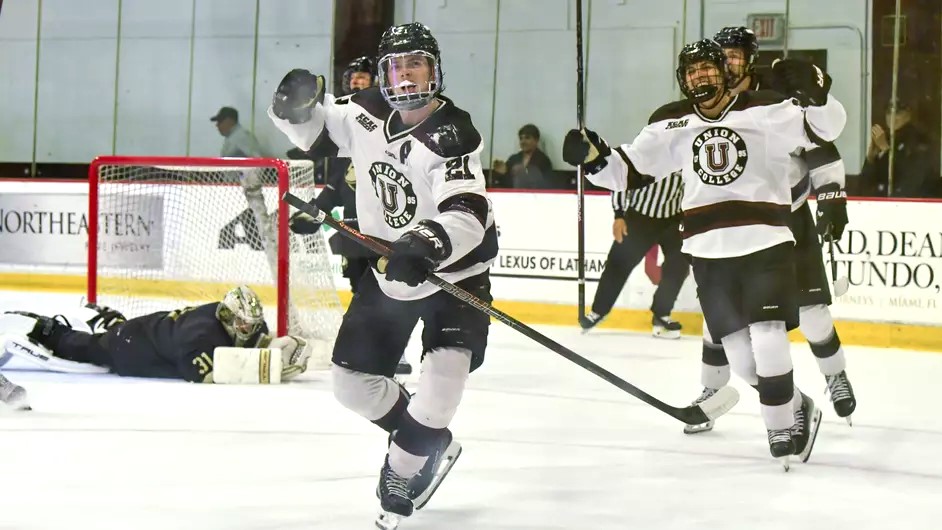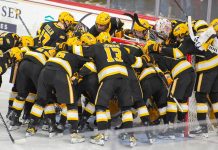
Each week during the season, we look at the big events and big games around Division I men’s college hockey in Tuesday Morning Quarterback.
Jim: Welcome back, college hockey! And welcome back to Tuesday Morning Quarterback, our weekly back-and-forth discussing college hockey’s news of the day.
Despite the fact that a handful of official games and an additional spattering of exhibitions were played this weekend, the biggest news right now comes from off the ice.
As USCHO.com first reported on Friday, the NCAA is planning on taking up a vote on emergency legislation that would allow players from the Canadian Hockey League (major junior) to play college hockey.
In the past, these athletes were considered professionals because they received stipends to play in the league making them professionals in the NCAA’s eyes. But in the age of NIL and compensating college players in many of the Division I sports, banning CHL players is no longer sensible.
It is a little too soon to know exactly how this will all shake out, but one thing is apparent: this will increase the player poll in Division I men’s college hockey, which is a good thing.
Again, we don’t know exactly how all of this will play out, but this feels like there is a lot of upside for college hockey, no?
Ed: I guess it all depends on who you talk to. We had a lot of conversations about this at the Frozen Four last year and the coaches discussed it at their convention in Naples the following month.
One of the most passionate people about making this happen when we talked in April was Don Lucia, as he saw the larger pool of players helping his league, the CCHA, and smaller programs in general. But I’m also certain that the top programs – the “blue chippers” – will still get the best talent.
There will be effects felt all through hockey. Canadian players who have wanted to go the NCAA route might now have more opportunities closer to home. With the BCHL having positioned itself as the top feeder league in Canada for college hockey in the U.S., it has meant that a lot of players in eastern Canada have had to play in the west or in U.S. leagues. If this changes, then someone from Montreal, for example, could play in the QMJHL and still have a college career at 19 or 20 years old.
The dominoes will be felt in other junior leagues in both the U.S. and Canada. With more attention now given to CHL teams, the leagues getting lesser attention in both countries may become less desirable for recruiters who only have so much time and travel budgets.
As far as the pool, I think it’s more likely that it stays the same and just ends up with players taking some new routes open to them. Perhaps some who considered Major Junior a better route but then found themselves with nowhere to go after they age out will land in college and that will help the numbers in the short term.
My question is whether there will be roster spots for more players. It seems as if the pending settlement in the House v. NCAA case might limit schools to 26 for hockey if they opt to offer a full complement of 26 scholarships. Could we see more talent chasing fewer opportunities?
Jim: No doubt limiting roster size at virtually the same time as you expand the player pool seems counterintuitive. But all of these separate legislations seem inevitable to college hockey.
To be more specific on what you reference, House vs. the NCAA, that is a court case that is close to being settled, the result of which will be limiting roster sizes in college athletics. For men’s and women’s college hockey, the proposed limits would be 26 players.
There is an upside to this, that schools would be allowed to provide every one of their players with 26 scholarships, a significant increase from the current limit of 18.
But 26 players, to me, seems far too low. Injuries and illness impact teams every year. I knew of multiple programs that last year were missing double-digit numbers of players. Could you imagine if those teams had just 15 or 16 healthy players each night? That seems like a senseless problem to create by establishing roster sizes.
Ed: In an ideal world without injuries or illness, 26 would be a good number. That would typically give you 15 forwards, 8 defensemen, and three goalies. Essentially that’s an extra line, extra pair, and extra netminder.
But we don’t live in an ideal world. Even teams with larger rosters can run into injury problems.
On Atlantic Hockey America media day, American International head coach Eric Lang noted that he likes to carry a larger roster, and under a cap of 26, he might have had to forfeit some games because of injuries last season. He advocated for at least 28 or 29 as did our Weekend Review colleague, Robert Morris head coach Derek Schooley, on this week’s edition of that podcast.
The settlement of the House vs. NCAA case was delayed by a judge in September, and there are many things to iron out. Plus, this case is not just about hockey, but NCAA sports in general.
I suppose the other way to increase the demand for players would be to expand the sport. But that’s a drum we and others have been beating for a while.
Despite all of this going on, hockey returned to the ice for D-I men this past weekend. There were a lot of exhibition games, but also some non-conference contests that will count in the PairWise.
What stood out to you?
Jim: I think the team that shocked me most was Stonehill. Under new head coach David Berard, a veteran college hockey coach, Stonehill pulled off an upset of an injury-plagued Merrimack team.
The Warriors unfortunately had to play an emergency backup goaltender in the game, but that shouldn’t take away from the fact that Stonehill came back late to tie the game and win in overtime.
Minnesota State also had a great win on Saturday against Michigan. And although it was an exhibition game, Augustana earned an emotional 4-1 victory over North Dakota just days after their assistant coach Chad Demers last his battle with brain cancer. Though the loss doesn’t hurt North Dakota, it could be a major confidence boost to a young Augustana team.
Ed: There was also a moment of silence and a recognition for Demers at Air Force’s game on Friday, a place where he had been a standout player and also served a season as director of hockey operations after a medical discharge from the Air Force.
On the ice, it was a disappointing weekend for Atlantic Hockey America as the teams went 2-10-0, going just 1-5 in one-goal games and 1-3 in overtime. That’s left a bit of a hole to dig out of for a conference that has not been able to get over the hump of a single NCAA bid more than once.
I don’t know if we saw too much else to bank on from this past weekend. Next weekend has a lot of good non-conference matchups, and AHA starts regular-season play (already!) with RIT at Mercyhurst for two.


